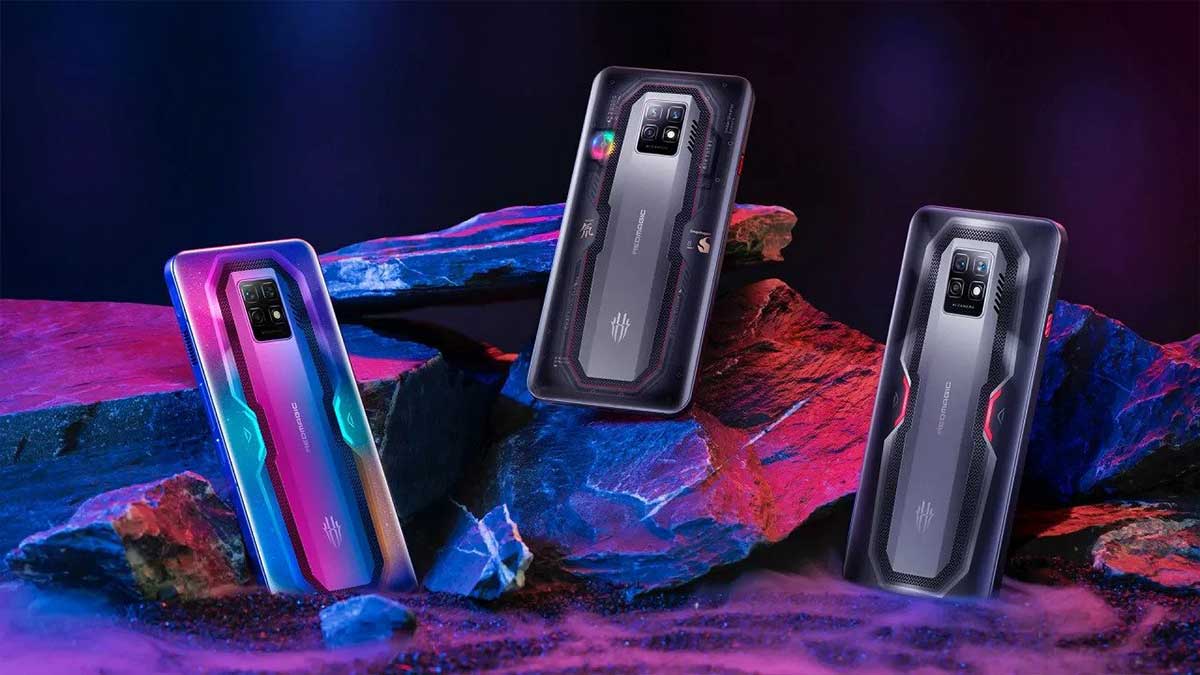
Red Magic
The proposal of gaming smartphones in Italy also counts on RedMagic 7 Pro: can you really play on a phone as if it were a console?
For some time now, there have been numerous manufacturers who have plunged into the gaming smartphone market, taking advantage of a growing public interested in bringing their favorite video games within reach of a pocket and handbag. Indeed, in today’s market, the boundaries between the platform in charge of the game and the platform on which those games can run have become increasingly blurred.
You can play on practically any device, with gaming that has never been so pervasive, but there are specific options for those who want to make the most of it. This is where proposals such as RedMagic 7 Pro come into play, the new Nubia phone designed specifically to enhance mobile gaming experiences, with a top-of-the-class technical data sheet and specifications.
We tested it for a few weeks on different video games and we’ll tell you how it behaved.
RedMagic 7 Pro: what’s in the box?
The gaming smartphone is presented right from the packaging, marrying the aggressive look and clear-cut geometries that often accompanies products designed for gamers. In its silver box, with logos that reflect RGB tones when exposed to light and some grayscale illustrations that refer to the world of comics, RedMagic 7 Pro comes with included in the package:
- RedMagic 7 Pro smartphone
- USB-C cable for power
- Wall socket to connect the cable to
- Accessory for extracting the SIM compartment
- Transparent silicone case
- Warranty documents.
The decision to include the case directly in the package is appreciable, but don’t expect a particularly elegant solution and the cover, curiously, is built as if it were a bumper – specially to protect the tops and corners, but leaving a large part of the back of the phone uncovered.
Technical specifications and design
At first glance, the phone impresses with its very particular design, which is not too subtle. Its 6.8″ AMOLED display undoubtedly plays the lion’s share, occupying the entire front without holes even for the camera, applied under the touchscreen – just like the fingerprint sensor.
The matte black bezels are pleasant to the touch: on the right side we find the volume rocker and the power button, flanked by the microphone port and one of the ventilation grilles. On the left side, we have the red switch that allows you to physically enter the gaming mode of the phone.
At the top we find the 3.5 mm jack to connect headphones, now a rarity in smartphones, while in the lower edge we have the port for the SIM slot and the USB-C port for recharging – essential, considering that recharging is not provided wireless.
If on the sides the phone is rather sober, it is on the back that surely divides enthusiasts between those who will love it for its showiness and those who will not appreciate it for the same reason. In the Obsidian version supplied to us we find an opaque black back in which a geometric pattern made of transparencies and RGB LEDs is inserted, on which the RedMagic logos stand out. At the top, we also find the box of the three cameras and flash, set inside the rear frame.
It is a particular and aggressive design, certainly over the top, which, like the packaging, chases the trends of the gaming world, between angular patterns and flashy lights. The sensation, holding RedMagic 7 Pro in your hands, is that it is a very solid and well-built smartphone, but also very heavy and thick.
Not surprising, considering its specs and cooling systems, but bear this in mind if you are one of those who love thin phones and don’t feel comfortable holding a (rather gigantic) smartphone in your hands.
The technical specifications
As for the data sheet, as mentioned, we received the Obsidian version of the smartphone from the manufacturer for our tests, which features 16 GB of RAM and 256 GB of internal storage.
The Supernova variant is also available on the market, which instead has 512 GB of internal storage (and costs 899 dollars, against the 799 dollars of our variant). Both are equipped with 5G technology.
The specifications of the model we are going to review are as follows:
| Specify | Details |
| Dimensions | 166.3 x 77.1 x 10mm |
| Weight | 235g |
| Display | 6.8″ 600 nits 1080×2400 AMOLED |
| Display ratio | 20:9 |
| Display density | 387ppi |
| Protection | Gorilla Glass 5 |
| Chipset | Qualcomm SM8450 Snapdragon 8 Gen 1 (4nm) |
| CPU | Octa-core (1×3.00 GHz Cortex-X2 & 3×2.50 GHz Cortex-A710 & 4×1.80 GHz Cortex-A510) |
| GPU | Adreno 730 |
| Storage | 256GB |
| RAM | 16GB |
| Main camera | 64 MP f/1.8 (wide) 8 MP f/2.2 (ultrawide) 2MP f/2.2 (macro) Video 8K 30fps, 4K 30fps/60fps, 1080p 30/60,120/240fps |
| Front camera | 16 MP f/2.0 1080p 30/60fps video |
| Battery | 5000 mAh, non-removable, 65W fast charging |
| Headphone jack | 3.5mm |
| Expandable memory | No |
| Extras | Back touch triggers with vibration 20,000 RPM cooling fans |
Game experience and user experience
It appears quite clear from the data sheet that we are talking about a monster of power capable of handling games with great fluidity – which is the key aspect of our review, given that we are on SpazioGames.it. For completeness, you can also deepen the review of our sister site Tom’s Hardware, more focused on the “telephone” aspect of the experience and based on the Supernova model.
During our tests with Call of Duty: Mobile, Genshin Impact, Asphalt 9, FIFA Mobile and several others, the phone has never suffered from slowdowns and has never shown itself to be unresponsive to our needs as players. The touchscreen, which reaches up to 120 Hz, gives the sensation of always being extremely responsive, especially in titles where the speed of response does everything, such as in Call of Duty.
Furthermore, the AMOLED display is a pleasure for the eyes and its pixel density returns clear images, with blacks of great depth. In summary, there’s very little to fault the RedMagic 7 Pro when it comes to what it was primarily built for – playing video games.
Moreover, although the operating system is Android 12, the phone runs on the proprietary RedMagic OS 5.0, which includes some software specifications designed to take full advantage of its remarkable technical data sheet. Using the physical key on the left side you enter gaming mode: a hub is opened, the Game Lobby, which lists all the video games found on the device, deactivates accidental touches and notifications, immediately activates the fans for cooling and allows, with gestures towards the side of the display, to call up a menu full of options.
This ranges from setting touch triggers on the back of the phone to displaying GPU and CPU usage on screen, including the current frame rate and creating macros and shortcuts. In short, if you are a geek, you will find everything you need – even considering that the phone can be purchased together with gaming accessories designed by the same manufacturer, such as external cooling systems (which you can also find on Amazon) and additional controllers, all manageable right from the gaming mode interface.
It is also true that some widgets integrated in normal use of the phone are far from captivating and you will wonder more than once why you should see the RPM of the fan on the main screen.
Furthermore, the translation of the menus is still lame and there are several voices that pass with disturbing agility from English to Spanish to a language that only vaguely resembles Italian. We hope that in this case Nubia will soon be able to improve the translations, to prevent users from missing out on the options offered by the phone just because they have not understood which voice allows them to be activated.
The gestures integrated into RedMagic OS are quite intuitive, including those that allow you to capture screenshots and start recording your gameplay. Also appreciated is the immediate option for setting the Hz of the display, which can be increased or reduced as desired, and that for managing the fan.
The cooling works quite well: during our sessions the phone became hot, yes, but never so hot that it was difficult to hold it in hand to continue playing, as happened to us with other proposals. This, at the “price” of hearing the fan in action quite noisily, considering that it can reach up to 20,000 RPM.
If during the game RedMagic 7 Pro lends itself quite well to its purpose despite its generous weight and dimensions, it could probably be a little more uncomfortable in everyday use. Given that we (obviously) don’t have the hands of a giant, wandering around social networks or juggling the camera options with such a full-bodied and rather heavy terminal might not be very agile in situations where you may be forced to stand up – think in train or subway.
Handling, however, hasn’t always been a flagship feature of gaming smartphones, so the RedMagic 7 Pro is just another proposition that proves the rule, doing no better or worse than its predecessors in making itself a little less full-bodied – also thanks to the need to guarantee a sufficiently large vapor chamber, an aerospace aluminum cooling structure and heat dissipation plates, essential for playing without catching fire.
In short, when you play you have the feeling of holding a terminal that makes no compromises and that makes brute force its business card, which does not struggle in the face of any title and which allows you to juggle with its numerous options. When you “reduce” it to being just a phone, the RedMagic 7 Pro might actually be a little more awkward – but, as always, if your primary need isn’t to play on your phone, then you shouldn’t aim for a product of this type.
Cameras and battery
Beyond the gaming experience, we also allow ourselves a few lines on some phone specifications, certainly important for all users.
First is the battery, which clocks in at 5000mAh and does the job quite commendably. We are talking about a solution that allows you to reach just over nine hours of use and defends itself well even by pushing the foot on the gaming pedal. In short, in normal use, you will never have to worry about being stopped by the phone before returning home.
The 65W fast charge is positive, but the possibility of wireless charging is missing, so you will always be forced to rely on a cable and wall socket (or cable and USB port on your computer) to replenish the energy of your RedMagic 7 Pro. On the other hand, you can keep the phone connected by cable while playing: it will be powered directly from the external source, without penalizing the battery.
A separate discussion also for the cameras, driven by artificial intelligence. Gaming smartphones often do the bare minimum at this juncture and, although RedMagic 7 Pro abounds in sensors, the results are not unforgettable.
On the front, without holes in the screen and practically imperceptible (and without loss of definition of the display, which is commendable) there is a 16 MP selfie camera, capable of capturing videos at 1080p and 60 fps. In this case, however, the result is forgettable – to say the least – with rather messy and grainy images, even in natural light conditions, where the phone often struggles to correctly manage exposure.
It’s definitely better with the rear cameras, especially when used in natural light conditions – as you can see in the shots below. In this case we are talking about a 64 MP main sensor, an 8 MP and 120 ° wide angle and a 2 MP and f / 2.4 macro lens, which are used depending on the mode chosen for the camera.
Set to automatic with natural light, the phone performs quite commendably, with bright and saturated photos, very nice to look at even if a little grainy when zooming in.
The macro lens is more complicated, because in some cases it goes out of focus very easily, even if you follow the indications on the screen. Indoors, it also produces a lot of noise, unless you set up some set lights that illuminate your subject very well.
The same happens, indoors, even with the other photographic modes: automatically the phone gets along better, but the risk of noise is always around the corner and sometimes even in manual, managing the various camera balances, you may not get the best of results.
In summary, in short, the rear cameras perform quite well outdoors and in natural light, they can be improved indoors and in low light conditions. The front camera, on the other hand, is recommended more than anything else for video calls, because it returns unsatisfactory photos even if only to share them on your social accounts.
Among other features, RedMagic 7 Pro mounts an under-display fingerprint sensor, which is also used to monitor your heart rate during the gaming experience – as long as you want to. It is another confirmation of the manufacturer’s desire to give priority first of all to the AMOLED display, under which both the fingerprint sensor and the selfie camera have been integrated.
RedMagic 7 Pro is also available in Italy: find more information on the manufacturer’s website, with the 256 GB model sold for 799 dollars and the 512 GB variant offered for 899 dollars. Certainly, important prices, but which are far from those of the most expensive top of the range and which denote an excellent relationship with respect to the remarkable technical data sheet.







